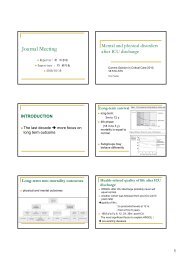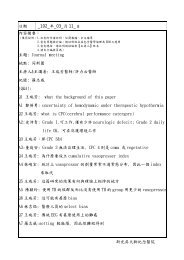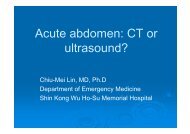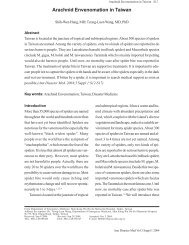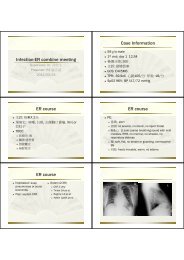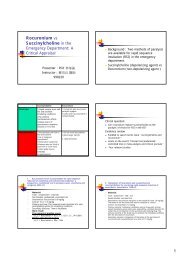Postpartum fever Postpartum fever Episiotomy breakdown ...
Postpartum fever Postpartum fever Episiotomy breakdown ...
Postpartum fever Postpartum fever Episiotomy breakdown ...
You also want an ePaper? Increase the reach of your titles
YUMPU automatically turns print PDFs into web optimized ePapers that Google loves.
Case: A 27 year-old woman<br />
presented with <strong>fever</strong>, left foot<br />
swelling after ten days of delivery<br />
<strong>Postpartum</strong> <strong>fever</strong><br />
Definition:<br />
ER R1王帝皓/ VS 洪世文<br />
The United States Joint Commission on Maternal<br />
Welfare defines<br />
<strong>Postpartum</strong> febrile morbidity as an oral<br />
temperature of 38.0 degrees Celsius or more<br />
on any two of the first 10 days postpartum,<br />
exclusive of the first 24 hours.<br />
low grade <strong>fever</strong> during this period is common<br />
and often resolves spontaneously, especially<br />
after vaginal birth.<br />
<strong>Episiotomy</strong> <strong>breakdown</strong><br />
<strong>Episiotomy</strong> infections are usually<br />
localized to the skin and subcutaneous<br />
tissue.<br />
Wound infection is diagnosed in 2.5 to<br />
16 percent of patients after cesarean<br />
delivery, generally four to seven days<br />
after the procedure.<br />
<strong>Postpartum</strong> <strong>fever</strong><br />
Differential diagnosis of<br />
postpartum <strong>fever</strong><br />
Urinary tract infection<br />
Wound infection (episiotomy or other surgical<br />
site infection)<br />
Mastitis or breast abscess<br />
Endometritis or deep surgical infection<br />
Septic pelvic thrombophlebitis<br />
Drug reaction<br />
Clostridium difficile-associated diarrhea<br />
Complications related to anesthesia<br />
Endometritis<br />
Endometritis is more common following<br />
cesarean birth than following vaginal birth.<br />
Fever; uterine tenderness; foul lochia; and<br />
leukocytosis, five days of delivery.<br />
A temperature ≥ 38 ºC in the absence of<br />
other causes of <strong>fever</strong>, such as pneumonia,<br />
wound cellulitis, or urinary tract infection, is<br />
the most common sign.<br />
1
Endometritis<br />
Endometritis is the most common puerperal infection,<br />
usually developing on the second or third day<br />
postpartum.<br />
Typically, the lochia has a foul odor and the white<br />
blood cell count is elevated. Fever and abdominal<br />
pain -> severe<br />
Often, a coexistent surgical wound infection is<br />
present.<br />
A search for retained products of conception is<br />
indicated, particularly if bleeding is ongoing.<br />
Urinary tract infection<br />
<strong>Postpartum</strong> women are at increased risk<br />
of urinary tract infection.<br />
Several factors have been implicated,<br />
including<br />
catheterization, epidural anesthesia, and<br />
vaginal procedures.<br />
Prevalence<br />
2.8 percent after cesarean<br />
1.5 percent after vaginal birth.<br />
Clostridium difficile-associated<br />
diarrhea<br />
More commonly, postpartum women.<br />
Watery diarrhea up to 10 or 15 times<br />
daily with lower abdominal pain<br />
cramping, low grade <strong>fever</strong>, and<br />
leukocytosis.<br />
These symptoms generally occur in the<br />
setting of recent antibiotic administration.<br />
Mastitis or breast abscess<br />
Lactational mastitis is a localized,<br />
painful inflammation of the breast that<br />
occurs in breastfeeding women.<br />
Breast abscesses develop when mastitis<br />
or cellulitis is not treated or does not<br />
respond to antibiotic treatment.<br />
Complications of anesthesia<br />
Complications of general anesthesia,<br />
such as aspiration pneumonia, can<br />
cause postpartum <strong>fever</strong>.<br />
Septic pelvic thrombophlebitis<br />
Occurs in the setting of pelvic vein<br />
endothelial damage and usually<br />
associated with<br />
endomyometritis, venous stasis, and<br />
hypercoagulability.<br />
However, it is a rare postpartum<br />
complication.<br />
2
Septic pelvic thrombophlebitis<br />
EPIDEMIOLOGY<br />
The incidence of SPT has fallen<br />
1 in 3000 deliveries (1 in 9000 vaginal deliveries and<br />
1 in 800 cesarean deliveries)<br />
Cesarean section (1:800 deliveries)<br />
Pregnancy (1 in 500 to 3000 deliveries)<br />
Pelvic infection (eg, postpartum endometritis, pelvic<br />
inflammatory disease)<br />
Induced abortion<br />
Pelvic surgery (eg, hysterectomy)<br />
Uterine fibroids<br />
Underlying malignancy<br />
Hormonal stimulation<br />
Ovarian vein thrombophlebitis<br />
ovarian vein thrombophlebitis (OVT), one week after<br />
delivery or surgery.<br />
Patients appear clinically ill; <strong>fever</strong> and abdominal pain<br />
localized to the side of the affected vein, the flank, or<br />
the back. Pelvic tenderness may reflect OVT or an<br />
alternative diagnosis such as endometritis.<br />
Nausea, ileus, and other gastrointestinal symptoms<br />
may occur but are usually mild<br />
PATHOGENESIS<br />
The physiologic conditions fulfill<br />
Virchow's triad for the pathogenesis of<br />
thrombosis<br />
endothelial damage<br />
venous stasis<br />
hypercoagulability<br />
CLINICAL MANIFESTATIONS<br />
fundal tenderness, lower abdominal<br />
tenderness, pelvic tenderness, or mass.<br />
Pelvic examination is poorly tolerated<br />
immediately postpartum.<br />
Deep septic pelvic<br />
thrombophlebitis<br />
Patients with DSPT usually present with <strong>fever</strong><br />
within three to five days, although the onset<br />
may be delayed to up to three weeks<br />
Patients usually do not appear clinically ill;<br />
<strong>fever</strong> or chills may be the only symptoms,<br />
Abdominal or pelvic tenderness is notably<br />
absent.<br />
DSPT is frequently a diagnosis of exclusion.<br />
3
Sequelae and prognosis<br />
Pulmonary emboli 2%; tend to be small and rarely<br />
cause hypoxia.<br />
There are case reports of other clotting processes<br />
with potential morbidity in the setting of SPT<br />
The mortality due to SPT is very low, due to septic<br />
emboli.<br />
In a study including 69 cases of SPT among nearly<br />
45,000 deliveries, no deaths were observed.<br />
The rate of recurrent SPT is approximately 3 per 100<br />
patient years.<br />
contralateral ovarian vein, left renal vein, or inferior vena<br />
cava.<br />
SPT is not increased maternal or fetal risk in<br />
subsequent pregnancies<br />
Diagnostic approach<br />
A suspicion of SPT should arise when<br />
<strong>fever</strong>, which usually follows a spiking<br />
pattern, fails to respond to standard<br />
broadspectrum antibiotic therapy.<br />
Septic pelvic thrombophlebitis was<br />
diagnosed in 20 percent of patients with<br />
prolonged febrile morbidity, defined as<br />
more than five days of <strong>fever</strong> regardless<br />
of appropriate antimicrobial treatment<br />
Image<br />
CT or MRI<br />
Criteria for diagnosis include<br />
(1) enlargement of the vein involved,<br />
(2) low density lumen within the vessel<br />
wall, and<br />
(3) sharp enhancement of the vessel wall.<br />
Ultrasonography may have a role in<br />
monitoring treatment response<br />
Journal review<br />
Diagnostic approach<br />
Patients often complain of flank and<br />
lower abdominal pain, typically<br />
described as noncolicky and constant.<br />
Pain may be of variable intensity and<br />
may radiate to the groin or upper<br />
abdomen, and paralytic ileus may occur.<br />
PE:<br />
tender abdominal mass described as rope<br />
or sausage-shape may be identified<br />
Lab<br />
The only laboratory test that may aid in<br />
the diagnosis and management of the<br />
disease is a complete blood count with<br />
blood cultures.<br />
Nevertheless, blood cultures provide<br />
identification of amicroorganism in less<br />
than 35 percent of the cases<br />
4
Management and treatment<br />
Clindamycin+Gentamycin +ampicillin<br />
“Triple antibiotic regimen” model.<br />
If <strong>fever</strong> persists after 5 days, SPT was<br />
suspected<br />
Anticoagulation<br />
If the imaging showed a small pelvic<br />
thrombosed vessel, therapeutic enoxaparin<br />
would be continued for 2 weeks.<br />
Heparin dosage<br />
Standard dosing of unfractionated<br />
heparin for management of SPT is an<br />
initial bolus of 5000 units followed by<br />
continuous infusion of 16 to 18 U/kg for<br />
a goal PTT of 1.5 to 2.0 times the<br />
patient's baseline<br />
Thank you<br />
5




